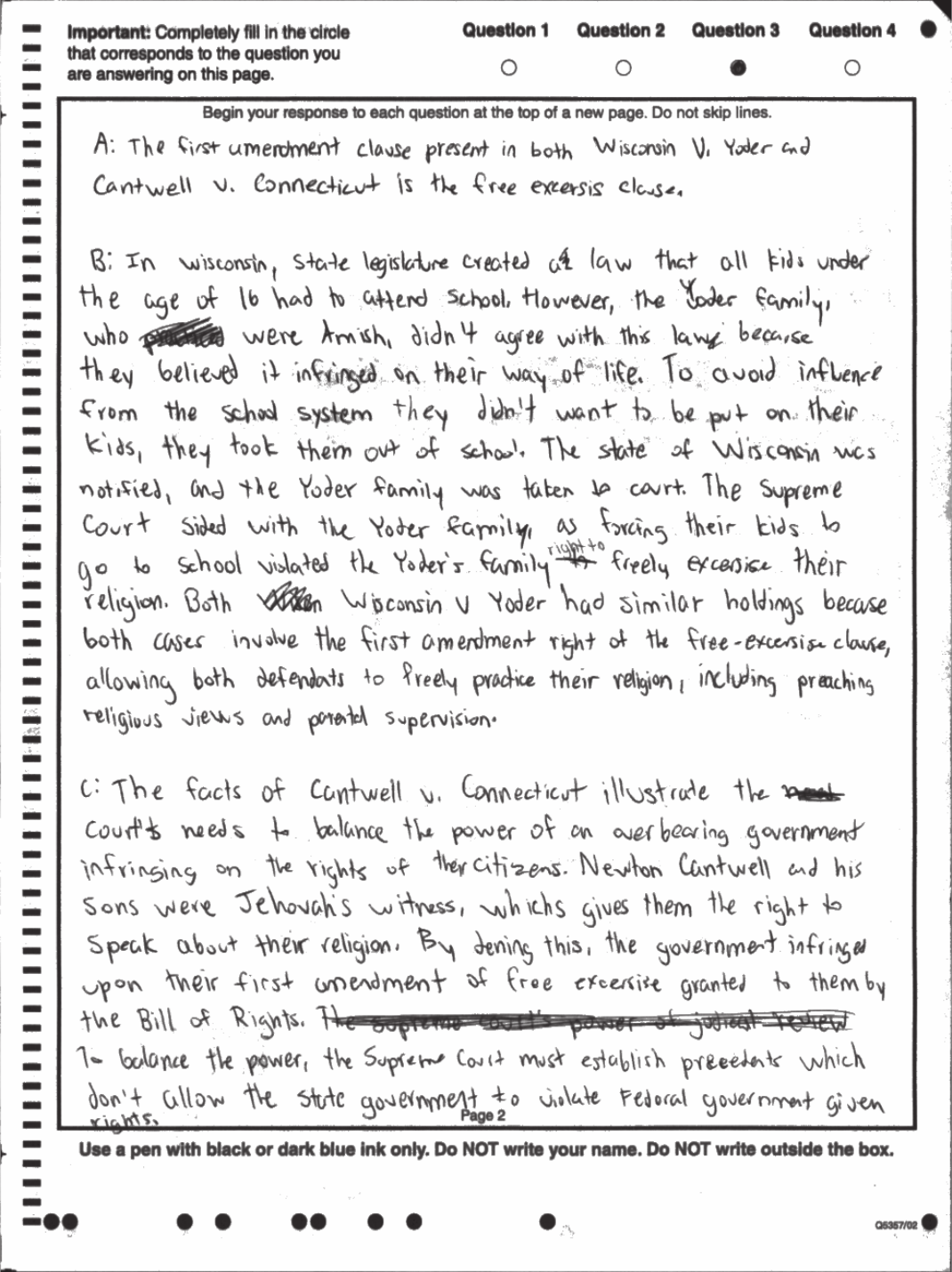
2023
AP
®
United States
Government and Politics
Sample Student Responses
and Scoring Commentary
Set 1
© 2023 College Board. College Board, Advanced Placement, AP, AP Central, and the acorn logo are registered
trademarks of College Board. Visit College Board on the web: collegeboard.org.
AP Central is the ocial online home for the AP Program: apcentral.collegeboard.org.
Inside:
Free-Response Question 3
Scoring Guidelines
Student Samples
Scoring Commentary

AP® United States Government and Politics 2023 Scoring Guidelines
© 2023 College Board
A.
Identify the First Amendment clause that is common to both Wisconsin v. Yoder
(1972) and Cantwell v. Connecticut (1940).
The free exercise clause
1 point
B.
Explain how the facts in Wisconsin v. Yoder and Cantwell v. Connecticut resulted in the
Supreme Court issuing similar holdings in both cases.
Acceptable responses include:
One point for describing relevant information (facts or holding) about the required
Supreme Court case.
• In Yoder, mandatory public school attendance beyond the eighth grade
was contrary to the religious beliefs of some Amish parents.
• In Yoder, the Court held that exemptions from school attendance requirements
for religious students were protected by the free exercise clause.
1 point
OR
OR
Two points for correctly explaining how the facts in both cases resulted in the Supreme
Court issuing similar holdings.
• While Yoder was about school attendance and Cantwell was about solicitation,
both cases concerned legal restrictions on religious practice. In both cases, the
Court held that the laws were unconstitutional because they violated the free
exercise clause.
• In Yoder, parents claimed that a law requiring school past the eighth grade
violated their religious beliefs. The Court held that exemptions from school for
religious students were protected by the free exercise clause. In Cantwell,
Jehovah’s Witnesses claimed that regulations on door-to-door solicitation were a
restriction on a religious practice. The Court held that their solicitation, even
without a permit, was also protected by the free exercise clause.
2 points
C.
Explain how the facts of Cantwell v. Connecticut (1940) illustrate the Court’s need to
balance government power and the rights of citizens.
Acceptable explanations include the following:
In Cantwell, the Court had to balance the government’s power to regulate door-
to-door solicitation with the right of citizens to freely practice their religion.
1 point
Total for question 3
4 points
Question 3: SCOTUS Comparison 4 points

3A 1 of 2

3A 2 of 2

3B 1 of 1

3C 1 of 2

3C 2 of 2
AP
®
United States Government and Politics 2023 Scoring Commentary
© 2023 College Board.
Visit College Board on the web: collegeboard.org.
Question 3
Note: Student samples are quoted verbatim and may contain spelling and grammatical errors.
Overview
This SCOTUS Comparison question asked the students to read a summary of a nonrequired case
(Cantwell v. Connecticut) and compare it to a course-required case (Yoder v. Wisconsin). Students were
asked to identify the First Amendment clause that was common to both cases. Additionally, students
needed to explain how the relevant facts in Cantwell and Yoder led to similar holdings. Lastly, the
students were required to explain how the facts of Cantwell illustrate the Court’s need to balance
government power and the rights of citizens.
These increasingly challenging tasks required a thorough understanding of the holdings of Yoder and
Cantwell, along with accurately comparing key facts between the two cases. Additionally, students
were asked to integrate relevant course concepts into the Court case comparison.
Sample: 3A
Score: 4
The response earned 1 point in part A by correctly identifying the free exercise clause as the clause
common to both cases.
The response earned the first point in part B by providing correct facts about Wisconsin v. Yoder by
stating that “it was an Amish family who were ordered by law that they must continue sending
children to school.” The response earned the second point in part B by describing the facts of
Cantwell, by stating that “the family couldn’t complete their distribution of church knowledge.” It
then explains why there was a similar holding, by stating, “In both cases, the Supreme Court ruled in
favor of the families in order to protect their gaurenteed rights as stated in the first amendment.”
The response earned 1 point in part C by stating, “The governments responsibility to regulate this
legislation, while also respecting the protections of the first amendment, is something that must be
balanced as both are important aspects of society and national safety.”
Sample: 3B
Score: 2
The response earned 1 point for part A because it correctly identifies the free exercise clause as the
clause common to both cases.
The response earned 1 point in part B point for describing factual information about the Wisconsin v.
Yoder case by stating, “In Wisconsin, state legislature created a law that all kids under the age of 16
had to attend school. However, the Yoder family, who were Amish, didn’t agree with this law.” The
response did not earn an additional point in part B because it does not attempt to state facts from the
Cantwell case and therefore cannot correctly explain how those facts led to a similar holding as
Wisconsin v. Yoder.
AP
®
United States Government and Politics 2023 Scoring Commentary
© 2023 College Board.
Visit College Board on the web: collegeboard.org.
Question 3 (continued)
The response did not earn a point for part C because it does not explain how the courts need to
balance the government’s power to regulate door-to-door solicitation with citizens’ rights to freely
practice their religion. Instead, the response restates information from the prompt and mentions the
First Amendment but does not coherently discuss the balance of government power and individual
rights.
Sample: 3C
Score: 1
The response did not earn a point in part A because it does not correctly identify the free exercise
clause as the clause common to both cases. Instead, it incorrectly names the establishment clause.
The response earned 1 point in part B point for providing factual information about the Wisconsin v.
Yoder case by stating, “In Wisconsin v. Yoder, Amish parents wanted their children to not stay in
public school passed eighth grade as it impacted their religious lifestyle.” An additional point was
not earned in part B because the explanation provided, that the “establishment clause ... allows for
this,” is incorrect. Additionally, the statement that “both cases gave the power to the people” is too
vague to be a sufficient explanation.
The response did not earn a point in part C because it does not use the facts of the Cantwell case to
explain how the courts need to balance the government’s power to regulate door-to-door solicitation
with citizen’s rights to freely practice their religion. The response states, “While there were laws in
place to shut down soliciting and going door to door distributing pamphlets about religion violates
this ordinance, the supremacy clause states that the constitution is the supreme law of the land,” but
this does not address the free exercise issue directly, and it does not specify the state governmental
interest relevant here to support Connecticut’s permitting requirement.
